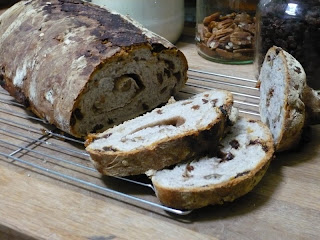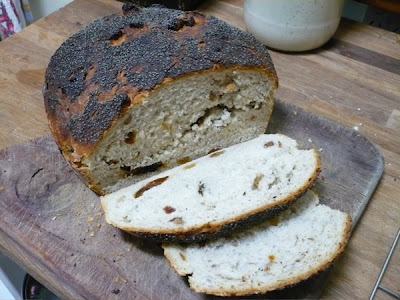Tuesday, October 6, 2009
New sourdough species
The kids helped with the bread making last night. The beast on the left is a giant cockroach and its friend is a spotty giraffe. Both have since been gobbled up my their makers.
Thursday, June 18, 2009
Dream of the brown turtle
 Amazing what comes out of the oven: one day a beautiful, perfectly formed loaf; the next, um, a turtle.
Amazing what comes out of the oven: one day a beautiful, perfectly formed loaf; the next, um, a turtle.Though it might not be immediately apparent, this is my interpretation of Ed Wood's cinnamon, fruit and nut loaf from Classic Sourdoughs. The recipe called for the dough to be rolled flat, spread with a sugar and cinnamon mixture, then rolled up and placed into a loaf tin. Not having any loaf tins of the right size I decided to try forming the two loaves-worth of dough into a single giant roll-up on a sheet.
Without a tin to hold the contents together a good deal of the molten sugar leaked out during baking, so that when the turtle emerged from the oven it was sitting in a small toffee lagoon.
 It looked much more appetizing when sliced open (best not to think of it as a turtle at this point) to display the raisins, walnuts and cinnamon scroll pattern within.
It looked much more appetizing when sliced open (best not to think of it as a turtle at this point) to display the raisins, walnuts and cinnamon scroll pattern within. The slices pictured here survived only briefly before being gobbled up by the kids. They enjoyed the toffee too.
Saturday, May 30, 2009
Foot fetish
Putting aside the slight set back with the rye starter (complete and utter failure would be more accurate but that undermines the inspiration a bit too much) I decided to try my hand at ciabatta: Italian slipper bread, so named, apparently, because the loaves resemble footwear (?)
I followed an excellent recipe on Mike Avery's hugely useful (and, indeed, hugely huge) Sourdough Home web site. I really enjoy Mike's writing style: it's encouraging and it cleverly manages to provide plenty of detail without being intimidating or overly technical.
I won't bother describing all of the steps. If you're interested you can consult Mike's recipe which I followed closely, apart from choosing to leave out the sun-dried tomatoes that he adds to the dough.
I did an extremely poor job of transferring the risen dough from bowl to baking sheet, ending up with oddly shaped things that, while very rustic, didn't look much like slippers to me... more like deflated giant sea cucumbers. But, after the final short proving, I bunged them into the oven and hoped for the best.
And here is the result...

One doesn't like to blow one's trumpet, but I venture to suggest that if Jamie Oliver or Antonio Carluccio had just whipped these out of the oven they would be well pleased. I couldn't believe how nicely they turned out.
As for the name: slippers doesn't even begin to describe how absolutely luscious and perfect in hand and mouth this bread is. Say ciabatta but think sesso e fantasia !
Try Mike's recipe for yourself, you'll love it.
I followed an excellent recipe on Mike Avery's hugely useful (and, indeed, hugely huge) Sourdough Home web site. I really enjoy Mike's writing style: it's encouraging and it cleverly manages to provide plenty of detail without being intimidating or overly technical.
I won't bother describing all of the steps. If you're interested you can consult Mike's recipe which I followed closely, apart from choosing to leave out the sun-dried tomatoes that he adds to the dough.
I did an extremely poor job of transferring the risen dough from bowl to baking sheet, ending up with oddly shaped things that, while very rustic, didn't look much like slippers to me... more like deflated giant sea cucumbers. But, after the final short proving, I bunged them into the oven and hoped for the best.
And here is the result...

One doesn't like to blow one's trumpet, but I venture to suggest that if Jamie Oliver or Antonio Carluccio had just whipped these out of the oven they would be well pleased. I couldn't believe how nicely they turned out.
As for the name: slippers doesn't even begin to describe how absolutely luscious and perfect in hand and mouth this bread is. Say ciabatta but think sesso e fantasia !
Try Mike's recipe for yourself, you'll love it.
Ryes and falls
Well, everything was going swimmingly with my first rye starter. After 24 hours it looked like this...

Lots of very promising little bubbles.
Another 12 hours later it looked like this...

Super ! I thought.
This is easy, I thought.
Pride comes before a fall and that's just what the starter did: fall, all the way back to a lifeless flour and water paste. Despite being fed for the next couple of days it stubbornly refused to come back to life.
I'll try again.

Lots of very promising little bubbles.
Another 12 hours later it looked like this...

Super ! I thought.
This is easy, I thought.
Pride comes before a fall and that's just what the starter did: fall, all the way back to a lifeless flour and water paste. Despite being fed for the next couple of days it stubbornly refused to come back to life.
I'll try again.
Saturday, May 23, 2009
Catch it in the rye
After reading Sarah Franklin's article on creating a rye starter I've been inspired to try it myself. And since the air here in Sydney has been well washed by all of the recent rain (it's been bucketing actually... dumping, pouring, pissing down, cats and dogs and almost elephants) I thought I'd take advantage of this and try a rye and rainwater concoction.
Actually, the various particles and poisons that nurture the lungs of city dwellers aren't really a concern in using rainwater to start the starter. After the culture becomes active, and the cycle of diluting, discarding and feeding has been repeated a few times using tap water, the concentration of any nasty bits will be, if not zero, then certainly a lot lower than what you're breathing.
There seems to be a good deal of disagreement between sourdough experts about whether the organisms that do the magic come predominantly from the flour used to create the culture or from the atmosphere. Perhaps it depends on the flour, or the place, or the phase of the moon, or whether you brushed your teeth that morning, or all of these and and a million and one other unknowable influences. I'm happy to take advantage of my profound ignorance on this question by choosing to believe that place matters: sourdough terroir. Hence the rainwater.
As Sarah's article illustrates, the steps required to start a rye starter couldn't be easier:

I'm using a yoghurt making flask with some tepid water in it to incubate the mixture.
To be continued...
Actually, the various particles and poisons that nurture the lungs of city dwellers aren't really a concern in using rainwater to start the starter. After the culture becomes active, and the cycle of diluting, discarding and feeding has been repeated a few times using tap water, the concentration of any nasty bits will be, if not zero, then certainly a lot lower than what you're breathing.
There seems to be a good deal of disagreement between sourdough experts about whether the organisms that do the magic come predominantly from the flour used to create the culture or from the atmosphere. Perhaps it depends on the flour, or the place, or the phase of the moon, or whether you brushed your teeth that morning, or all of these and and a million and one other unknowable influences. I'm happy to take advantage of my profound ignorance on this question by choosing to believe that place matters: sourdough terroir. Hence the rainwater.
As Sarah's article illustrates, the steps required to start a rye starter couldn't be easier:
- mix rye flour and water into a goop
- keep goop warm-ish
- wait

I'm using a yoghurt making flask with some tepid water in it to incubate the mixture.
 |  |
To be continued...
Thursday, May 21, 2009
All creatures great and small and chewy
The younger bakers in the family got to work and created some wonderful sourdough animals. Here they are in their gestating form, a giant ladybird on the left, and elephant and smiley face on the right...
And here they are, resplendant after their metamorphosis in the oven and looking forward to being gobbled up by their creators (such is life)...

 |  |

Saturday, May 16, 2009
Nothing like a nice date
I decided to try a fruit loaf this morning. I used much the same recipe as in this post but with the addition of a couple of tablespoons of honey to the mix. After the dough had been kneaded for five minutes or so I added a good handful of whole dried dates, and another of crushed walnuts, folding them in a bit at a time and kneading for another couple of minutes.
 I popped the dough into a round cake tin, then glazed the top with honey water (using the sticky fingers or baker's fondle technique) and sprinkled on a generous amount of poppy seeds.
I popped the dough into a round cake tin, then glazed the top with honey water (using the sticky fingers or baker's fondle technique) and sprinkled on a generous amount of poppy seeds.
Because it was quite a large loaf with moist dough (to allow the dates to suck some of that moisture up) I baked it at about 400°F for half an hour and then reduced the heat to about 350°F for another twenty minutes. This worked really well: the loaf cooked through nicely while the top crust was crispy but not too think or overdone.
The verdict: boffo - a good one ! Even the youngest member of the family, renowned for brutally honest food criticism, gave it the thumbs up.
 I popped the dough into a round cake tin, then glazed the top with honey water (using the sticky fingers or baker's fondle technique) and sprinkled on a generous amount of poppy seeds.
I popped the dough into a round cake tin, then glazed the top with honey water (using the sticky fingers or baker's fondle technique) and sprinkled on a generous amount of poppy seeds.Because it was quite a large loaf with moist dough (to allow the dates to suck some of that moisture up) I baked it at about 400°F for half an hour and then reduced the heat to about 350°F for another twenty minutes. This worked really well: the loaf cooked through nicely while the top crust was crispy but not too think or overdone.
The verdict: boffo - a good one ! Even the youngest member of the family, renowned for brutally honest food criticism, gave it the thumbs up.
Subscribe to:
Posts (Atom)



